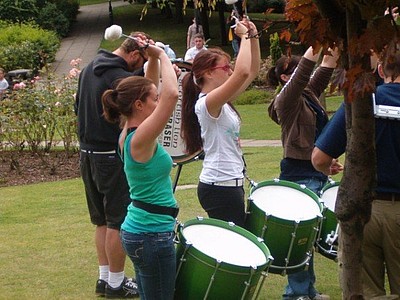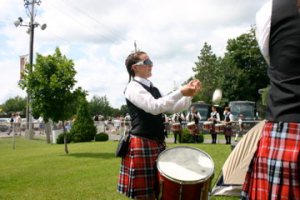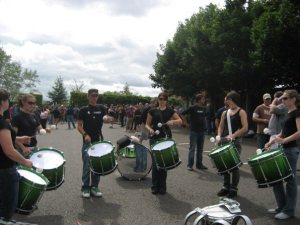About - what is bass and tenor drumming?
What does a bass drummer in a pipe band do?
In a pipe band, the bass player is the heart beat of the group. Bass drummers carry the physically largest instrument, and help keep the time steady for the pipers and the snare drummers, who all have many more notes to play in every bar than the bass does. Every note the bass drummer plays, however, is of utmost importance, since the tempo and stability of the whole group's playing relies on the rock-solid internal clock of the bass drummer.
What is a tenor drummer? How do tenor drummers fit into a pipe band?
A tenor drummer in a pipe band is a member of the drum corps, and specifically belongs to the midsection (or bass section/tenor and bass section/middle section) within the band.
A tenor drummer uses a combination of flourishing and rhythmic playing, to provide both a visual interpretation of the pipe/drum music and emphatic rhythmic accents. Tenor drums are tuned to select notes of the Great Highland Bagpipe scale, and can also provide melodic and harmonic support to a pipe band performance.
What is flourishing?
Flourishing, also known as swinging, is a way of presenting a visual interpretation of the music that is being played by the snare drummers and pipers by performing motions with the arms and the tenor sticks (mallets/beaters), which are tied to the fingers of the tenor drummer. The range of movements that are choreographed with the music ranges from simple arm movements to very complex spinning sequences, and often also involves bringing the sticks down to the drum in order to strike important accents, rhythms, or notes. Personal and regional style influences the way that tenor drummers perform flourishes, and both style and players' abilities influence the selection of different types of movements that are played with different tunes.
What is rhythm?
In the pipe band tenor drumming world, rhythm playing is the word used to describe the musical phrases that are played by striking the drum. The rhythms played are often composed to align with the rhythm that is played by the snare music, which in turn is composed to accompany the pipe music. Rhythm is written in musical notation, and complexity of the rhythms written is aligned with the level of the band and, often, the ability of the players.
What is a flourishing tenor drummer?
I define the term "flourishing tenor drummer" as a tenor drummer who flourishes exclusively and never actually strikes the drum. This is not a universal definition. Some consider than any tenor drummer who flourishes is a "flourishing tenor drummer", however, today, arm movements and flourishing are such an important part of the art of tenor drumming that a flourishing tenor drummer can and should be called simply a "tenor drummer".
The converse argument is that rhythm playing is so essential to the art form as well that it is imperative that tenor drummers, even those with very strong flourishing abilities and weaker rhythm abilities are still expected to hit the drum at certain moments (although every band has its own style and may not follow this guideline, which is totally ok!).
Flourishing tenors in the 1970s (ish) used hard mallets with tassels on them that sounded terrible when striking a tenor drum. The advantage of these sticks was that they slowed down the movement of the tenor stick so that the flourishes could be more visible and prominent. This was the style at the time and was based on military tradition.
Tenor drummers today must flourish much more quickly in order to also be able to grasp the sticks and strike the drum at the proper moment.
What is a rhythm tenor drummer?
Similar to the term "flourishing tenor drummer", "rhythm tenor drummer" is a term that is fairly out dated. A rhythm tenor is a tenor drummer who does not flourish, a practice that became very popular in the 1990s, however these days, most rhythm tenors still do some arm movements to help create a uniform look across the corps....so I consider rhythm tenors to be tenor drummers in their own right. Often they are specialists in rhythm, sometimes with a snare drumming background, and they usually will play more intricate rhythms in place of more complex flourishes. Today most tenor drummers are expected to do some rhythm and some flourishing in their presentation (of course, every band has its own style, so this statement does not apply universally).




